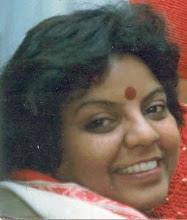

Think Before you Dance
Madhavi Mudgal shares her thoughts on dance and dancers in a cosy baithak, reports Nirupama Dutt
When does a work of art find completion? When it meets an appreciative audience, of course. It is really the old tale of the Narcisus brooding a thousand years until it meets the human gaze. So it is in the order of things that the artiste comes closer to the audience. Both artiste and audience could not have had it better when Odissi dancer Madhavi Mudgal came face-to-face with a wide range of connoisseurs at Rasik: Meet the Ariste, a monthly series organized by Seher in baithak style at the basement theatre of the India Habitat Centre. The first in the series which took off on the first
Saturday of November featured Madhavi, but not in isolation. Her contemporary and equally celebrated Bharatnatyam dancer Leela Samson played the catalyst in the role of a moderator.
For once the two of them were not dancing but sitting with mikes pinned to their blouses talking dance. Which made Leela wonder if they had got so old that instead of dancing they were sitting and talking dance! But talking has its uses and more so in the adda style of Bengal which is hard to come by in the hurry-scurry of Delhi or happens in very small, exculsive groups. And going by the large turn-out of Rasiks, Sanjeev Bhargava and his Seher seem to have done it right.
Madhavi first came through as the young girl growing up amidst music and dance. She was born to it, of course, being daughter of the celebrated musicologist Pt. Vinay Chandra Mudgal of the Gandharva Mahavidyalya. And this girl instead of becoming a singer like her brother Madhup Mudgal found her feet tapping to the beat. It was kathak first along with her studies for she reached right up to the final year of a course in architecture when she finally took the decision to dance her life away as it were.
``Why did you change from Kathak to Odissi?’’ asked Leela. ``I found Kathan restrictive in the chakara and and footwork. The element of showing-off was too strong. Odissi gave me room to explore the creative impulse better,’’ was Madhavi’s answer. But towards the close of the tete-a-tete, with a couple of demonstrations thrown in by Madhavi and her students, a former student’s mother pointed out to the dancer that Kathak gave an abandon whereas Odissi was fixed in composition. So Madhavi turned to do a bit of Kathank to show that even that was bound.
Among the many things that surfaced in the evening –from the emotional life of a dancer to the nights awake after the performance, from the theme shows which seemed to have stepped into the realm of classical dance to the retirement age of the dancer—the strong motif was of the `thinking dancer’ to which Madhavi referred time and again. In fact, both Madhavi and Leela have a reputation for belonging to the breed of thinking dancers. That does not make them less feeling or performing. It is that they have the capacity to make conscious choices and articulate and defend them. But painter Jatin Das (incidentally there were quite a few painters at the meet ) wanted to know what this `thinking dancer’ was all about! A valid intervention and Madhavi admitted that thinking was not necessarily the yardstick for creativity.
When asked the `awful question of who her ideals in dance were, Madhavi’s quick reply was ``Guru Kelucharan Mahapatra and Birju Maharaj ‘’ Both these names came up more than once as dancers who were the dance and one could not tell one from the other as Yeats once said. But Leela was not letting off madhavi so easily. ``Tell us who is your ideal from among your contemporaries’’. Madhavi had Leela blushing when she replied, ``you and I mean it.’’
The evening, which strectched over two hours, was made very lively with audience participation. When the talk of what was classical and contemporary got too complex, poet Ashok Vajpayee got up and said, ``These classical dancers as we know them and see them are a creation of this century and so it was a case of the classical being contemporary too.’’ Rasik Vasant Sathe gave the comic relief to the evening with his comments on arts and artists. But when he said ``Modern art has gone beyond every thing,’’ Mumbai-based painter Prabhakar Kolte was quick to retort: `Well, politics has gone beyond everything else. ‘’ The Baithak was a sure success with so many think thanks around.
Indian Express, November 1999

No comments:
Post a Comment